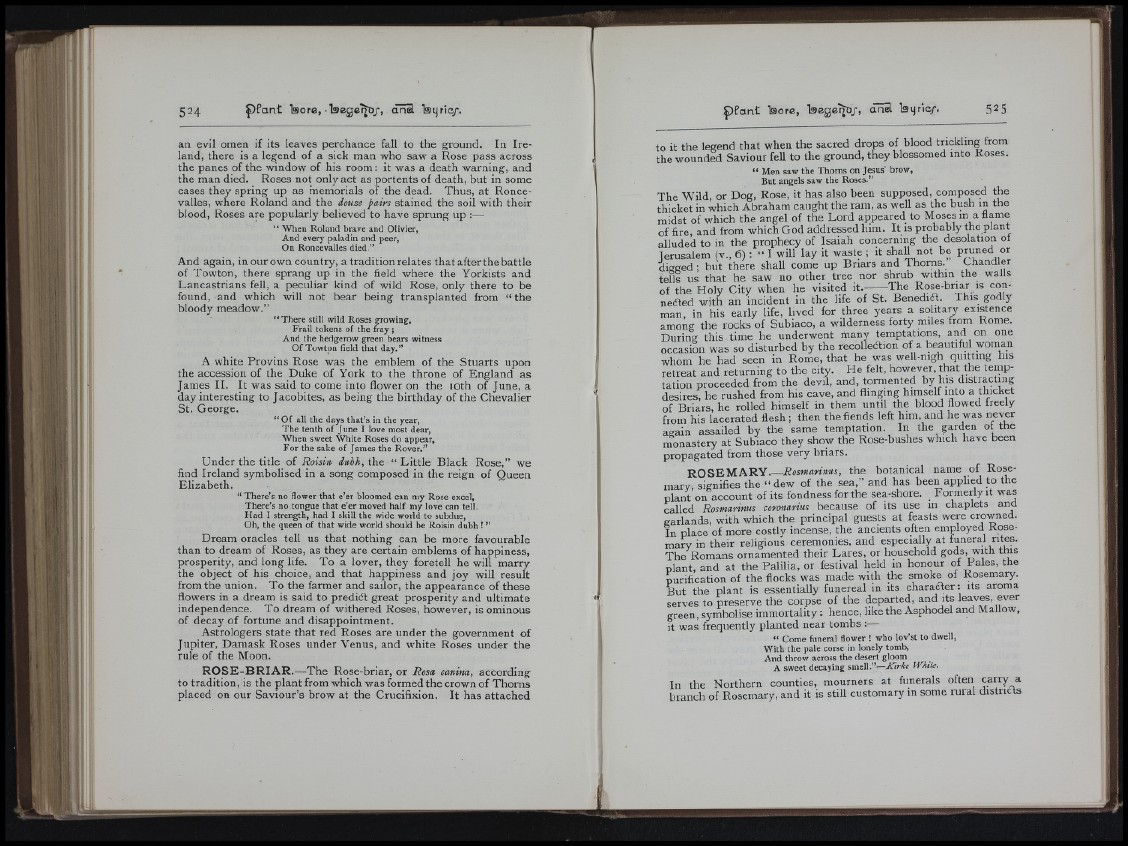
mz.:
"1-f
lil i
tAL
lil
8 ir
i
an evil omen if its leaves perchance fall to the ground. In Ireland,
there is a legend of a sick man who saw a Rose pass across
the panes of the window of his room: it was a death warning, and
the man died. Roses not only act as portents of death, but in some
cases they spring up as memorials of the dead. Thus, at Ronce-
valles, where Roland and the douze pairs stained the soil with their
blood, Roses are popularly believed to have sprung up :—
When Roland brave and Olivier,
And every paladin and peer,
On Roncevalles died ”
ii
And again, in our own country, a tradition relates that after the battle
of Towton, there sprang up in the field where the Yorkists and
Lancastrians fell, a peculiar kind of wild Rose, only there to be
found, and which will not bear being transplanted from “ the
bloody meadow.”
“ There still wild Roses growing,
Frail tokens of the fray ;
And the hedgerow green bears witness
Of Towton field that day.”
A white Provins Rose was the emblem of the Stuarts upon
the accession of the Duke of York to the throne of England as
James II. It was said to come into fiower on the 10th of June, a
day interesting to Jacobites, as being the birthday of the Chevalier
St. George.
“ Of all the days that’s in the year,
The tenth of June I love most dear,
When sweet White Roses do appear,
For the sake of James the Rover.”
Under the title of Roisin dubh, the “ Little Black Rose,” we
find Ireland symbolised in a song composed in the reign of Queen
Elizabeth.
“ There’s no flower that e’er bloomed can my Rose excel,
There’s no tongue that e’er moved half my love can tell.
Had I strength, had I skill the wide world to subdue,
Oh, the queen of that wide world should be Roisin dubh! ”
Dream oracles tell us that nothing can be more favourable
than to dream of Roses, as they are certain emblems of happiness,
prosperity, and long life. To a lover, they foretell he will marry
the object of his choice, and that happiness and joy will result
from the union. To the farmer and sailor, the appearance of these
fiowers in a dream is said to predicff great prosperity and ultimate
independence. To dream of withered Roses, however, is ominous
of decay of fortune and disappointment.
Astrologers state that red Roses are under the government of
Jupiter, Damask Roses under Venus, and white Roses under the
rule of the Moon.
R O S E - B R IA R .—The Rose-briar, or Rosa canina, according
to tradition, is the plant from which was formed the crown of Thoms
placed on our Saviour’s brow at the Crucifixion. It has attached
f
to it the legend that when the sacred drops of blood tnckhng from
the wounded Saviour fell to the ground, they blossomed into Roses.
“ Men saw the Thorns on Jesus' brow,
But angels saw the Roses.”
The Wild, or Dog, Rose, it has also been supposed, composed the
thicket in which Abraham caught the ram, as well as the bush in the
midst of which the angel of the Lord appeared to Moses in a flame
of fire, and from which God addressed him. It is probably the plant
alluded to in the prophecy of Isaiah concerning the desolation ot
Jerusalem (v., 6) : “ I will lay it waste ; it shall not be pnmed or
digged; but there shall come up Briars and Thorn/ Chandler
tells us that he saw no other tree nor shrub within the walls
of the Holy City when he visited it. The Rose-briiar is conneaed
with an incident in the life of St. Benedia. This godly
man, in his early life, lived for three years a solitary existence
among the rocks of Subiaco, a wilderness forty miles from Rome.
During; this time he underwent many temptations, and on one
occasion was so disturbed by the recolleaion of a beautiful woman
whom he had seen in Rome, that he was well-nigh quitting his
retreat and returning to the city. He felt, however, that the temptation
proceeded from the devil, and, tormented by his distracting
desires, he rushed from his cave, and flinging himself into a thicket
of Briars, he rolled himself in them until the blood flowed freely
from his lacerated flesh ; then the fiends left him, and he was never
again assailed by the same temptation. In the garden of the
nionastery at Subiaco they show the Rose-bushes which have been
propagated from those very briars.
r o s e ma r y . — the botanical name of Rose-
marv, signifies the “ dew of the sea,” and has been applied to the
plant on account of its fondness for the sea-shore. Formerly it was
called Rosmarinus coronarius because of its use in chaplets ana
garlands, with which the principal guests at feasts were crowned.
In place of more costly incense, the ancients often employed Rosemary
in their religious ceremonies, and especially at iuneral rites.
The Romans ornamented their Lares, or household gods, with this
plant, and at the Palilia, or festival held in honour of Pales, the
Durification of the flocks was made with the smoke of Rosemary.
But the plant is essentially funereal in its characiter: its aroma
serves to preserve the corpse of the departed, and its leaves, ever
green, symbolise immortality : hence, like the Asphodel and Mallow,
it was frequently planted near tombs :—
“ Come funeral flower ! who lov’st to dwell,
With the pale corse in lonely tomb,
And throw across the desert gloom
A sweet decaying smell.”—Ktrke Whiie.
In the Northern counties, mourners at funerals often carry a
branch of Rosemary, and it is still customary in some rural distriéts